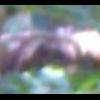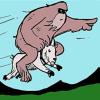Factual?! (But not misleading?) http://www.channel4.com/programmes/bigfoot-files/articles/all/usa-hair-samples
25093 – Sample provided by Derek Randles (donated via Jeffrey Meldrum)
1. Date of sample collection: 2011 (precise date unknown)
2. Location of sample collection: Olympic Peninsula, Washington, USA
3. Colour of hair sample: Medium Brown
4. Length of hair sample: c. 100mm
5. Other physical characteristics: Fine thickness and crinkled in appearance
6. Details surrounding sample collection: Collected by Derek from a tree trunk in the Olympic Mountains. The site in question has been investigated by the Bigfoot research group ‘The Olympic Project’. Multiple Sasquatch encounters have been reported in the location, including sightings and acoustic phenomenon such as wood-knockings.
7. Result: Canis, wolf or dog
The Olympic thermal was taken in Oct 2013. We shouldn't be stringing unrelated facts together just to prove our points. If you do have a better connection, please post a link.
As far as sasquatch not showing up on game cams. There is another large mammal that has been reported in both the Olympics and the GPNF, that to the best of my knowledge, also hasn't shown up on a game cam: wolves.
http://wdfw.wa.gov/conservation/gray_wolf/reporting/sightings.html
Please, don't come back and say, "but they have shown up on game cams elsewhere." I know they have. I have seen the wolf pictures from the Okanogan National Forest when they were first taken. But so far they have been able to avoid the cameras in the two above mentioned areas.
This is part of a post I made in another thread:
http://bigfootforums.com/index.php/topic/5116-cascades-carnivore-project-how-do-they-miss-the-bigfoots/page-43 #848
A possible tactic that could be used would be to switch to daytime Plotwatcher type cameras with no flashes and a timer instead of sensors to trigger the cams. They also cover a much larger field of view. Place them across suspected areas of bigfoot travel, higher up (16' or so), as inconspicuously as possible, about 150' apart. With enough cameras to cut across an area of a quarter mile or more. And set them up with cameras facing cameras. About 20 cameras would do it. A little spendy for an individual to do.
The higher up part is important. It gets the cameras out of line of sight and scent. There are quite a number of sighting reports from hunters in tree stands. Probably for this very reason.
If we can't get any pictures for whatever reason, then maybe we should change tactics.



